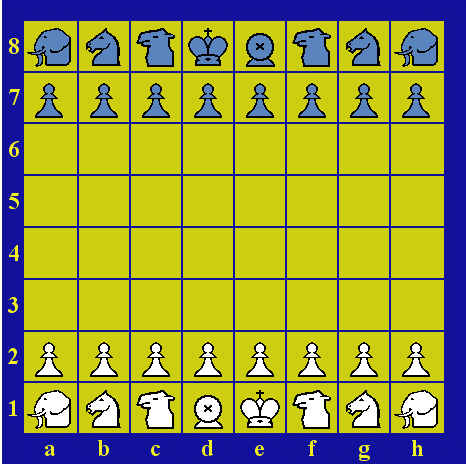Hindustani Chess
By John Ayer
Introduction
H. J. R. Murray described this Asiatic offspring of European adventurers in Chapter IV of his History of Chess. The rules of Hindustani Chess seem to have been relatively coherent (though this may be the result of faulty sampling).
This game was played in central and northern India in the nineteenth century. It appears to be descended from the game brought in by the European traders at the start of the seventeenth century. There were some minor local variations in the rules.
Board
The board was still the original one on which chess was invented: eight squares by eight, uncheckered, but with the first, fourth, fifth, and eighth squares of the first, fourth, fifth, and eighth rank and file specially marked.
Setup

(Setup image created with Game Courier by the editor.)
The king and minister stand on the two central squares on the first rank, with the king on the right and the minister on the left from each players point of view. They are flanked on each side by a camel, then by a horse, and lastly by an elephant. The elephant may be replaced by a chariot or boat, and the camel may not be invariant, though the horse is always a horse. Pawns fill up the second rank.
Pieces
The moves are approximately the same as in European chess. The piece in the corners, whatever its shape, has the rooks move, the horse has the knights leap, the camel or other piece next inboard runs along the diagonals, and the minister has the queens move. The pawn moves one square forward, except when it captures one square diagonally forward. The king moves one square in any direction, and cannot castle, but once in each game may leap like a knight. He may exercise this power after he has moved, but not after he has been checked.
The pawn-promotion rules are quite complicated. A pawn reaching the eighth rank is promoted to the rank of the master-piece of that file BUT:
1: The player must have already lost a piece of that rank; the player can never have more of anything than he started with.
2: On the c or f file, the camel (bishop) that could reach that square must already have been lost (and remember that the board was not checkered).
3: On either central file, promotion is to vizier (provided, of course, that the vizier has been lost).
4: A pawn on the seventh rank cannot advance to the eighth unless the proper promotion-piece is available to replace it. It must remain motionless, a stationary target. Whether it can offer a check that could not be executed is not stated; logic suggests that it could not.
Rules
Checkmate is a win. Depriving an opponent of all his pieces except the king (pawns dont matter) is a half-victory. Perpetual check is a draw. Reduction of each side to a king and one other man is a draw. Stalemate is not permitted; a move that inflicts stalemate is invalid.
Notes
Source: Murrays History of Chess, pages 8082.
Credits